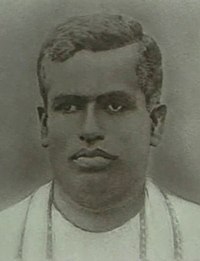Kumaratunga Munidasa
| Kumaratunga Munidasa කුමාරතුංග මුනිදාස |
|
|---|---|
 |
|
| Born |
25 July 1887 Idigasaara, Dickwella, Matara, Sri Lanka |
| Died | 2 March 1944 (aged 56) |
| Nationality | Ceylonese |
| Alma mater | Dikwella Buddhist School, St.Thomas' College, Matara, Dikwella Watarukanna Pirivena (Wewurukannala Pirivena) |
| Occupation | Writer, poet, journalist |
| Known for | Hela Havula |
| Spouse(s) | Lilie |
| Children | 2 Daughters & 4 Sons |
| Parent(s) | Palavinnage Dona Gimara Muthukumarana (Mother), Abious (or Abiyes) Cumaranatunga (Father) |
Kumaratunga Munidasa (Sinhala: කුමාරතුංග මුනිදාස; 25 July 1887 – 2 March 1944) was a pioneer Sri Lankan (Sinhala) linguist, grammarian, commentator, writer, poet, and journalist. He founded the Hela Havula movement which sought to remove Sanskrit influences in the Sinhala language promote its correct usage. He is believed to be one of the most eminent scholars Sri Lanka has known for several centuries. He is known best for his profound knowledge of the Sinhala language and literary work.
Munidasa was born on 25 July 1887 in Idigasaara, Dickwella in the Matara District. He was the 12 th of 13 children. His mother was Palavinnage Dona Gimara Muthukumarana (or Dona Baba Nona Muthukumarana) and father Abious (or Abiyes) kumaranatunga was a physician practicing indigenous medicine who kept invaluable Pali and Sanskrit manuscripts on Ayurveda, Astrology and Buddhism.
Munidasa first studied at the Dikwella Buddhist School. Later his father died and he attended St. Thomas' College, Matara. Then he attended the Dikwella Watarukanna (Wewurukannala Pirivena) Pirivena to learn Pali and Sanskrit in order to become a Buddhist monk. But due his family's discontent, he entered the Government Teachers' College in Colombo. He graduated after two years of training in 1907.
His first appointment was as a government teacher in Bilingual School of Bomiriya. Later he was promoted to principal of the Kadugannawa Bilingual School. After eleven (11) years he was promoted to inspector of schools, which he held for four years.
He wrote his first book in his school days; Nikaya Sangraha Vivaranaya, an analysis for a Scripture on Buddhist Monastic Orders.
...
Wikipedia
